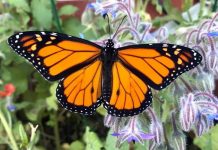In nature, any species is sought after by other predator or prey species, which detect it through their senses (sight, hearing, smell). Victims can defend through venoms, unpleasant smells, run, or by deceiving the sensory input of their predators. One method is camouflage and mimicry. It is a balance between prey and predator bypassing this defense.
To camouflage (homochromy) in order to escape predators or to surprise the possible preys is to melt into the hues and shapes of the environment. The method can be simple or elaborated (the inversed shadow), making the animal melt into its environment.
Polar animals, like the polar bear and polar owl, are white. In the savanna, lions employ camouflage. They remain for large periods of time immobile in the bush without anybody being aware they are there, due to their tawny color. This tactic is especially efficient during the dry season, when the prey is scarce and the lions cannot afford losing food for being detected early by their prey. The same camouflage color is used by the African ground squirrels or prairie dogs, which use the autumn hues in their coat for deceiving predators.
Many insects (like grasshopers), snakes and birds (like parrots) have a green color that makes them difficult to distinguish in the grass or in the forest. Movie makers spend a lot of time detecting a leopard in the wild, even if they are abundant in an area… Most bottom fishes, like rays and angelfish, cannot be distinguished from the substrate. Some animals have cryptic shadow: they are dark above and light below, like tuna and many other fishes.
Homochromy can change with the season, like the ptarmigan and arctic hare, which are brown in the summer and white during winter.
Homotypy goes further than camouflage: the animals copy natural elements or plant organs with an amazing precision. Stick insects really look like a stick (their name Phasmatodea comes from the Greek "phasma" "phantom") and even imitate during their movements the shaking of a stick blown by the wind. Some Thai stick insects even mimic dead branches covered by lichens. The same imitation is made by some caterpillars and beetles (like Petrognatha gigas of western Africa). Leaf insects not only imitate a green leaf with nerves, but also the attack of fungi on the imaginary leaf! The same patterns are achieved by some Brazilian locusts.
The leafy sea dragons, relatives of the sea horses, can be differentiated with difficulty from algae.
Orchid mantis (Hymenopus coronatus) from southeastern Asia mimics so well a pink flower, that pollinating insects go straight into the killing arms of this predator, while others praying mantis from the same are mimic tree bark. Many moths too mimic tree bark.
Some caterpillars replace a plant bud before turning into a cocoon and the cocoon looks exactly like the replaced bud.
The tiny black toads (Oreophrynella) from the Roraima tepui in Venezuela have the color and texture of the rocks on which they live and this is also the case with many butterflies and the tree bark or dead leaves.
Some butterflies from Costa Rica completely lack color, being completely transparent. The frogmouths from Australia and nightjars have a plumage that makes them difficult to distinguish from the tree bark.
The chameleons’ ability to change color is well-known, depending in which environment they are found at a given moment. But they are amateurs compared to the ability of the octopuses, cuttlefish or flounders.
Some animals play dead as an active method of defense: many predators will only eat prey which is alive…The opossum is the most famous when it comes to playing dead, hence the term "playing possum". Many snakes, too, use this strategy, and besides the immobility, they expel through some anal glands a decomposing corpse scent… Besides discouraging animals that eat only living prey, playing possum also convinces some large animals that the individual is no threat to their young.
Many insects (like wasps or caterpillars), spiders, venomous fish and snakes (like kraits and coral snakes) and toxic amphibians (like salamanders, fire-bellied toads and poison dart frogs) warn about their toxicity through bright colors and elaborated patterns.
That’s why many species have developed mimicry: imitating the colors and patterns of the real dangerous animals, so that their predators won’t attack them, being deceived.
There are flies imitating the color of the wasps and many non-toxic butterflies imitating toxic species of butterflies. Over 15 genera of non-venomous snakes imitate in Americas the model of the highly venomous coral snakes… The Myrmecium spiders mimic nasty ants.
There are even non-toxic moths imitating the ultrasounds emitted by toxic moths, being avoided this way by the bats. Sometimes, the predator imitates the prey, to get closer easier, like in the case of some beetles. Some parasite flies imitate the bumble bees in whose nest they depose their eggs.
The caterpillar of a hawk moth, Hemeroplanes ornapus, from Central America, has a length of 8-10 cm (3.2-4 in). When menaced, the pseudopods of the rear part hold the body (using sucking cups), while the thorax dilates to maximum, and this coupled with two fake shiny eyes and the hanging of the fore part of the body, make the caterpillar resemble a small snake.

































